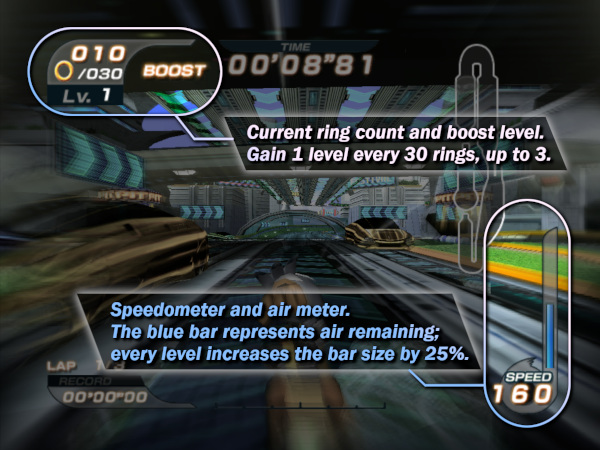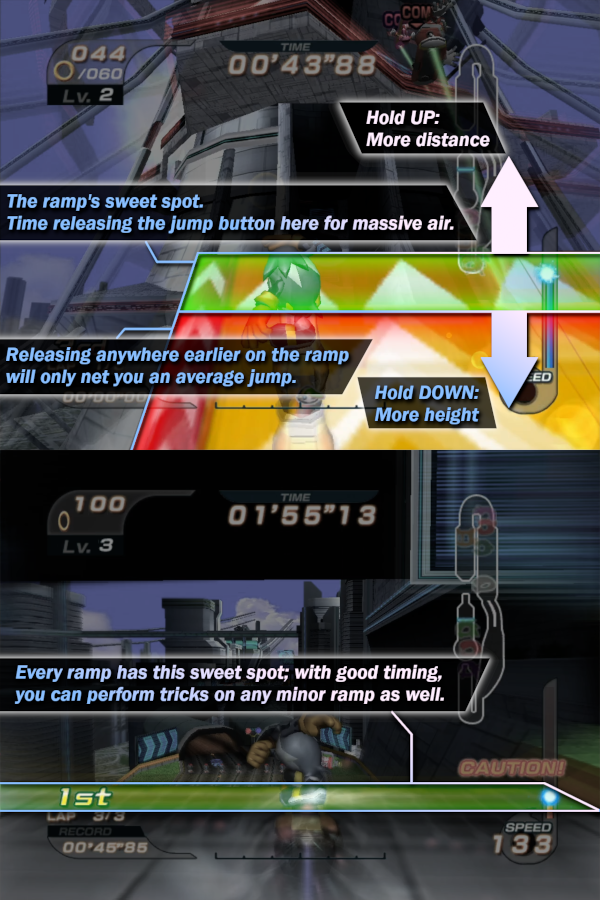Welcome to Sonic Riders! Snooping around the extras, you may have noticed there is a tutorial movie. You may have also noticed that this movie only tells you about very basic mechanics you could've figured out yourself and is overall very unhelpful. It tells you about turbulence, the air system, and character specialties, and that's about it, and even then it's pretty lacking.
Here's what SHOULD be in there.

The air system is the game's primary mechanic: it's your fuel system, and you need it to be able to jump, boost, and air slide (drift), but all of these things deplete it, so you have to spend it wisely and make the most of your opportunities to restore it. Every 30 rings you collect will give you a boost to your maximum air capacity and overall speed, capping at level 3, which gives you a huge advantage. Often, but not always, a track will have a hidden box with 100 rings in a hard-to-reach place that will be automatically bring you to level 3; memorizing the locations of these could be very useful. Boosting or air sliding near another racer will knock all of the rings out of them, which can be vital for dealing with a particularly tenacious opponent, but be careful: they can do the same to you! Theoretically you could use the tornado mechanic the tutorial mentions to keep them away, but this uses so much air that it's basically never worth it and nobody ever uses it. I don't think I've ever even seen the computers use it.
The primary way to regain air is by performing tricks: after going off a ramp, you can do tricks by pressing different directions, and the more you successfully perform will increase your trick ranking and give you more air when you land. However, if you land while in the middle of a trick animation, you'll get a C and receive no air; remember to let go of the controls before you land and especially that you should not still be holding forward, because that WILL screw you over. To perform more tricks, charge up your jump and release the button at the very edge of the ramp, and the longer you charged the faster you'll be able to move. In addition, holding a direction while you charge and jump will affect the angle you fly when you leave the ramp: holding forward gives you more distance, while holding backwards will give you more height. Fully charging a jump at a specific angle (usually high) will allow you to reach several important shortcuts. Large ramps will automatically always allow you to perform tricks even if you're out of air, but charging jumps will allow you to perform tricks off of any minor ramp as well.

(Also, each track has an automated portion where you're prompted to either spin the stick or, if you're using keyboard controls, mash left and right to restore massive amounts of air; if you're playing the PC verion, just holding both keys works during these, which provides a nice breather.)
For air sliding, it's important to remember acceleration is automatic in this game; holding forward messes with the precision of the slide because the game expects you to only be holding left or right. Once you're locked into a slide, you can press the opposite direction to subtly correct your movement. Aside from that this is pretty standard drifting, except unlike your standard racing game you want to use this as sparingly as possible because it consumes as much if not more air than boosting.

Turbulence is the game's built-in way of justifying rubberbanding: rather than the computers magically getting faster the further ahead you are, racers in the lead leave behind a wind trail that others can ride for additional speed and do tricks off of for extra air. Unlike traditional racing game rubberbanding, you get to take advantage of this too (and believe me, you will need to.) Doing tricks off of turbulence is as simple as moving to the side with the arrows, no further input required, and can occasionally launch you into a shortcut path above the main track. However, turbulence can very easily drop you at just the right angle to send you flying off the edge of the track or railroad you so you can't take advantage of shortcuts to the side, so it's important to learn when and how to avoid it as well.
Each character is one of three types: Speed, Flight, and Power, each of which have their own shortcuts clearly marked on the track that only they can use and restore a considerable amount of air. Speed characters can use grind rails scattered around the track, and can do so by jumping and then pressing the jump button again in midair to latch on. Flight characters can use dash rings floating in the air, which launches them forward, and while airborne their vertical controls are inverted. Power characters can punch through obstacles and weak walls, each of which restores a little bit of air; because Power characters clear obstacles out of the way, other characters can take advantage of Power shortcuts by following Power characters through them before they respawn. Using rings earned in races, you can buy special gear that allows characters of any type to use a specific type shortcut.
That's about everything you really need to know. Best of luck out there!